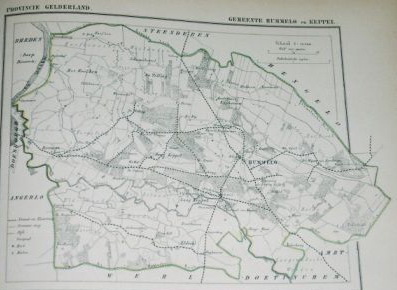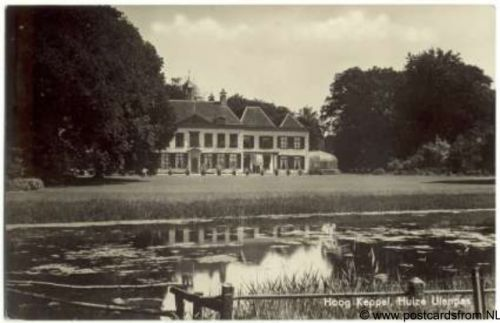The Jewish Community of Hummelo and Keppel
List of names of genealogical relevance mentioned in the article (in order of appearance):
Abraham Israel Frank, Benjamin Moses, Benjamin Simon(s) Katz, Sara Levy, Josef Katz, Sibilla Benjamin, Hertz van Bingen, Mientje Daniels Levy, Jacob David Rosendaal, Sara Simons, Levi Philip, Elias Philips, Mozes Marcus Berlijn, Hartog Marcus Berlijn, Levy Marcus Berlijn, Daniel Birnbaum, Benjamin Reichenberger, Jacob Jacobs, Casper Cohen, Salomon (Sam) Jacobs, Betje Goldsteen, Dr Robert Paul Belinfante, Marianne Lisser.
Family trees of relevance:
Jacobs, Goldsteen, Vomberg(for Herz van Bingen & Katz connections)
It appears that in the Duchy of Gelre there was around 1350, beside Nijmegen, Zutphen and Doesburgh, also a small Jewish community in Keppel. The Jews of Keppel, as well as those residing elsewhere, were blamed for the pest that was ravaging the population, and apparently all of them perished.
No data have been handed down from the centuries of presumed early settlement of Jews in Hummelo and Keppel. However, a tale was told in 1646 about two Jewish cattle traders from the village of Goor, who attempted to maneuver several fat cows past the toll gate in the dark of night (a toll was known to have been in force at least since 1436). The guard at the tollgate, however, was vigilant. He chased the traders, confiscated the animals and corralled them at the toll station.
In the 18th century there appears on a list of tenants at the court of Gelre one Abraham Israel Frank who resided in Keppel in 1722, and Benjamin Moses, registered at Baak. Benjamin Simon, born on may 16, 1747 in Keppel, adopted around 1812 the family name Katz Benjamin was a poor calf slaughterer, who married fifteen-year old Sara Levy (born in 1766 in Elten).
The couple moved to the village of Drempt where six sons were born to them: Simon (August 1781), Josef (December 1793), Levy (July 1797), Israel (February 1799), David December 1799) and Mozes (abt 1802) In 1801 the family of Benjamin Simons (Katz), who lived already in Drempt in 1793 had been denied residence in Doesburg, but in February 1803 two residents of Drempt, Olbert Evers and Hendrik Smit, gave an official hand-pledged warranty for the Katz family at the municipality of Doesburg, where after they were permitted to settle there. The household soon expanded to include three daughters, born between 1803 and 1805. Many of the descendants of Benjamin Simon and Sara Levy, all of whom lived in Doesburg, found their deaths in German extermination camps during 1942/43. Josef Katz, who died in Doesburg in 1860, is the only one of whom a gravestone is preserved. His corporal remains, together with 13 stone fragments, were moved 100 years later to the Jewish cemetery at Doetinchem.
In January 1764 a man was arrested for allegedly having taken, according to his confession, "a new bed sheet from the inn De Beer (The Bear)", and selling it to the Jewish woman who lives opposite the water mill in Keppel for the sum of 15 stuyver. This is according to a report and request for additional information submitted by the judge to his nephew, the Judge at the township Doetinchem.
The identity of this Jewess in Keppel cannot by now be established. A certain Sibilla Benjamin of Keppel (mother or aunt of Benjamin Simon Katz?) possessed a black cap, and the widow Garritsen had in her home 'De Roskam' some children's clothes which she had bought from a peddler, a colorful character named Carel van Hessel Cassel, The man was in custody on the suspicion of trading in stolen goods, and theft of a bed sheet, a cap, and children's clothing. The outcome of the inquest and the judge's ruling are not known.
The family of butcher Hertz van Bingen and his wife, Mientje Daniels Levy, lived around 1785 in the community of Angerlo. Their children Benjamin, Marcus and Mari (or Meijken) were born between 1788 and 1797 in Angerlo. The Van Bingen family moved to Doesburg around 1798.
Hummelo and Keppel never had an independent congregation. Of the total population of 880 inhabitants in 1812, only six were Jews, who belonged to the regional synagogue in Doetinchem. Among these were Jacob David Rosendaal, his wife Sara Simons, and the children Levy and Flora. Jacob Rosendaal was born in Perleburg, Prussia, and resided since 1797 in Hummelo. The Rosendaal family moved to Doetinchem in 1811, having obtained permission from the local congregation's governors. Moreover, the Magistrate of Hummelo had provided Jacob Rosendaal with a certificate of good conduct: "In my function as Magistrate of Community Hummelo I hereby certify that the Jewish merchant Jacop Davids has resided already for fourteen years at said community and that up to the present day he has conducted himself as a virtuous and honest resident". Warrantors for Jacob Rosendaal were Loan Banker Levi Philip of Doetinchem, a merchant, and also a lodge proprietor in Doesburg.
At the beginning of the 18th century a licensed merchant by name of Elias Philips lived in Hummelo. Elias pressed charges in november 1822 against a butcher in Lower Keppel for failure to deliver a cow's hide. The defendant was sentenced in the Doesburg court to pay a compensatory sum of five guilders, and legal expenses.
Mozes Marcus Berlijn, cloth merchant, died at Hummelo on july 12, 1832. Some three months later, october 22 to 25 inclusive, portions of his legacy (bales of cloth, personal belongings, furniture) were auctioned off at the lodging mansion 'De Gouden Druif (the Golden Grape)' in Hummelo. The auction was announced by wall posters in Hummelo and neighboring towns and villages, and was directed by the deceased's brothers and heirs Hartog Marcus Berlijn of Doetinchem, the Hummelo merchant Levy Marcus Berlijn, and a beadle of the court. A notary oversaw the proceedings. In total, some 586 items were sold within the four days of auction, including the shop exhibit articles and a number of other objects. Mozes Marcus had evidently journeyed the markets, besides owning a shop. The list of cloth yardage that was sold provides a good picture of the merchant's store inventory, as well as a fair idea about the preferences of the local dwellers of Achterhoek country.
Daniel Birnbaum settled in Hummelo with his wife Aleida Eeltink in 1874. Prior to his arrival he had closed a signed agreement with the farmer Bernard Garritsen to care for him in old age. Against the paid sum of 900 guilders Garritsen would provide Birnbaum with bed and board, and sick-nursing as needed, for the rest of his life. Birnbaum would shoulder the cost of medical care. In case that Birnbaum would wish to discontinue his stay, Garritsen would return the initial sum with detraction of expenses incurred per year. The deal was arranged through a Doesburg notary.
Concurrent with the notarized contract, Birnbaum composed his will: he bequested the fruits of his legacy to his wife, and deeded his assets with the exception of his pension and personal articles to his caretaker Bernard Garritsen On may 21, 1875 Birnbaum retracted his will and ordered the following emendations: Bernard Garritsen would receive his full legacy, and his wife only the sum of fl.100. One wonders what kind of matrimonial drama had taken place there.
A brief note in local sources tell of a series of lectures by cloth merchant Benjamin Reichenberger of Doetinchem, presented at the Society for Merit and Delight in 1889 in Hummelo. The recital artist booked a marked success and won great acclaim.
The family of Jacob Jacobs lived as of 1995 in Lower Keppel (Laag Keppel). Jacob, butcher by trade, was born in the nearby village of Wehl. His daughter Jetje, born in 1901, was wedded in 1922 to the Aalten-born merchant Casper Cohen in the Doesburg synagogue. In that town they had six children. Apparently they transferred around 1936 to the Boliestraat in Doetinchem. During the war four out of the six members of the Cohen family were deported to the concentration camps from where they did not return.
Another son of Jacob Jacobs, Salomon (Sam) Jacobs, was born in 1903 in Lower Keppel. He married Betje Goldsteen, from Meppel. Dr Westerbeek van Eerten, a well-known physician devoted several pages in his memoirs to the family of the butcher Jacobs. In May 1931 he was present at the brismileh (circumcision ceremony) of Sam and Betje's son Jozef, and he writes a lively description of the ritual and its participants, the mohel and the sandek on his raised ceremonial armchair, holding the week-old baby. A typical utterance of Van Eerten concerning the Jewish tradesmen: "How would an Achterhoek cowman get his cattle to be sold on market without Jewish middlemen managing the handclap signal tricks of the trade?"
Butcher Jacobs, in 1932, asked Chief Rabbi J. Vredenburg for permission to expand his meat business with pork sales, which would be conducted in a separate space. Naturally the Rabbi turned down the request for reasons of kashrut.
A yearly tally in 1938 by the local newspapers reported 3179 souls in the Hummelo-Keppel community, ten of them Jews, including 3 of the Portugese affiliation.
The couple of physicians Belinfante–Lisser, residing in Hummelo, attempted suicide on May 13, 1940 shortly after the Germans occupied Holland. Dr Robert Paul Belinfante died in Doetinchem, Marianne Belifante-Lisser survived the attempt.
Marianne Lisser died in her place of hiding in IJlst(Friesland) on 10 January 1944.On 8 April 1946 she was reinterred alongside her husband Robert Paul Belinfante in the cemetery of Hoog-Keppel.
According to the national population census there resided on october 1, 1941, four Jews of Dutch nationality (the family Jacobs) and one German-born, in the Hummelo-Keppel district were not included in the statistics.
In august 1941, members of the Dutch resistance in the Achterhoek had cut the German military telephone lines some 28 times. Jan Veldkamp, a 17-year old smith's apprentice from Hummelo, had perpetrated 20 of these acts of sabotage. He was arrested around September 20, 1941, transferred via Arnhem to the Moabit prison in Berlin, where he died in the summer of 1943.
In retaliation, the Germans carried out punitive razzias in Twente, the Achterhoek district, and elsewhere. Sam Jacobs was arrested during the razzia of October 8, 1941 and transferred to Mauthausen, where he died on October 31, 1941. He was 38 years old, and the first Nazi victim of the village. His wife Betje Goldsteen died on October 22, 1943 in Auschwitz.
In the autumn of 1942 a number of male Jews who had been arrested in the large cities were imprisoned in camp 'De Wittebrink'. Camp leader was Mr. Burggraaf, and the already-mentioned Dr. Westerbeek van Eerten dispensed medical services. After a few weeks the SS took a group of the men to a destination unknown.
Palestine pioneers
The present short description of the Jewish community in Hummelo/Keppel omits what befell the small group of Palestine pioneers (Chalutsim), most of them not Dutch citzens. They had found shelter during 1939, among other places, at the youth hostel 'De Kleine Haar' in Gorssel, and from the spring of 1941 they dwelled in 'Het Oude Huis' in Lower Keppel.
The story of this group appears in the book (in Dutch) 'The Jews of "De Kleine Haar" in Gorssel', by S. Laansma-Zutphen, 1986 (available at the genealogical Library in Jerusalem). The relevant data will be incorporated in the present pages.
Source:
Hans Kooger “Het Oude Volk”, pag.76-80
Published by: “Staring Instituut/Mr.H.J.Steenbergenstichting”, Doetinchem, 2001 (Slightly revised).
With permission of the author.
Translation:Ithamar Perath, Trudi Asscher
Amendments and research:Ben Noach, Ithamar Perath, Trudi Asscher.
(“Joods Leven in Doesburg” by Hans Kooger, death certificates in Genlias)
29 sources and research references used by the author are specified on page 80 of the source.
Source for death and burial details of Marianne Lisser: werkgroep kamp wittebrink (Karl Lusink)
[an error occurred while processing this directive]
[an error occurred while processing this directive]

